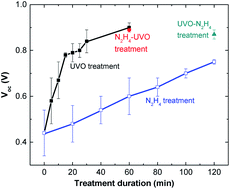MXenes with tunable work functions and their application as electron- and hole-transport materials in non-fullerene organic solar cells†
Abstract
MXenes as 2D materials have attracted great attention due to their high electrical conductivity, high surface area, high transparency in the visible range and high hydrophilicity. They have been investigated in devices and systems including batteries, supercapacitors, and sensors as well as in catalysis but not in optoelectronic devices. In this work, we studied the application of Ti3C2Tx for electron and hole collection in organic solar cells (OSCs). The work function of Ti3C2Tx can be increased by a UV–ozone treatment and decreased through a treatment with N2H4. It can be thus tuned in a range from 4.08 to 4.95 eV. MXene films with different work functions are studied as electron and hole collection buffer materials for non-fullerene organic solar cells (OSCs) with poly[(2,6-(4,8-bis(5-(2-ethylhexyl)thiophen-2-yl)-benzo[1,2-b:4,5-b′]dithiophene))-alt-(5,5-(1′,3′-di-2-thienyl-5′,7′-bis(2-ethylhexyl)benzo[1′,2′-c:4′,5′-c′]dithiophene-4,8-dione))] (PBDB-T) and 3,9-bis(2-methylene-(3-(1,1-dicyanomethylene)-indanone))-5,5,11,11-tetrakis(4-hexylphenyl)-dithieno[2,3-d:2′,3′-d′]-s-indaceno[1,2-b:5,6-b′]dithiophene (ITIC) as the active materials. The OSCs with MXenes for electron or hole collection layers can exhibit a power conversion efficiency of 9.06% or 9.02%. These efficiencies are comparable to those obtained using conventional charge-collection buffer materials.



 Please wait while we load your content...
Please wait while we load your content...